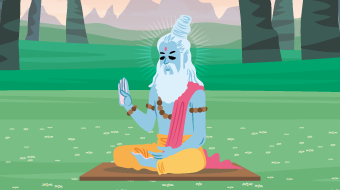For many years science and spirituality were believed to be of contradictory nature, but they are sides of the same coin – embossing mystery and curiosity. While science explores the mysteries of physical energy, spirituality unveils the energies that we carry within us, often navigating through similar principles.
The missile man of India, Dr. Kalam, often emphasised how fact and faith must coexist as a value system in a developed society. In one of his speeches, he quoted Maharishi Patanjali from Yoga Sutra: “When you are inspired by some great purpose, all your thoughts break their bounds, your mind transcends limitations, your consciousness expands in every direction and you find yourself in a new and wonderful world as the dormant forces, faculties and talents come alive and you discover yourself to be a greater person than you ever dreamt yourself to be.” To this he added that a scientist’s mind accompanied by a spiritual force can lead to the creation of a beautiful and prosperous world, indicating an amalgamation of the scientific and spiritual energies.
From Danish physicist and Nobel Prize winner Niels Bohr, to German theoretical physicist Werner Heisenberg, Nobel Prize-winning Austrian-Irish physicist Erwin Schrodinger, and many others have shown interest in Vedic studies.
Once sidelined in comparison to modern science as old and irrelevant, spiritual texts are now garnering attention for not just the great storytelling but the secrets they might hold. When attempts have been made to study the scriptures, there have been significant revelations about Quantum Physics, about the cosmos, and the human body.
For instance, the Bhagavad Purana talks about the formation of atoms (anu) from two sub-atoms (paramanus), the Vedic teachings display a parallel with the Wave Function, the Puranas narrate the life cycle of the sun and the moon. Some theorists also draw parallels between the law of conservation of energy and the Bhagavad Gita where the soul is referred to as energy; between the dance of vibrations in quantum theory and the dance of Nataraja.
The Sanskrit language in itself is said to be a tool that develops scientific thought, enhances observational skills about the real world, further aiding critical thinking and reasoning abilities.
It is not to say that all the scientific discoveries might already be there in the ancient Indian texts, but they might provide a direction to the discoveries being conducted. It is certainly something to ponder upon how texts that were written centuries ago, have stark similarities with notable scientific theories being proven now.
If not that, then just tuning in to the energy within as a spiritual endeavour, often through mediation, can itself enhance the creative thought process and focus. Researchers claim meditating can change the structure and function of the brain due to relaxation, further improving focus, learning concentration, and memory. Other studies have stated experienced meditators to be better problem solvers as mindfulness through meditation expands open-mindedness and the capacity to respond to situations. Ontologically, mindfulness has the potential effect of enhancing creativity by building empathy and cognitive skills.
That is surely something our scientists can benefit from while making important breakthroughs for a better world!
This article was originally published in the Science & Innovation issue of The Plus magazine.

